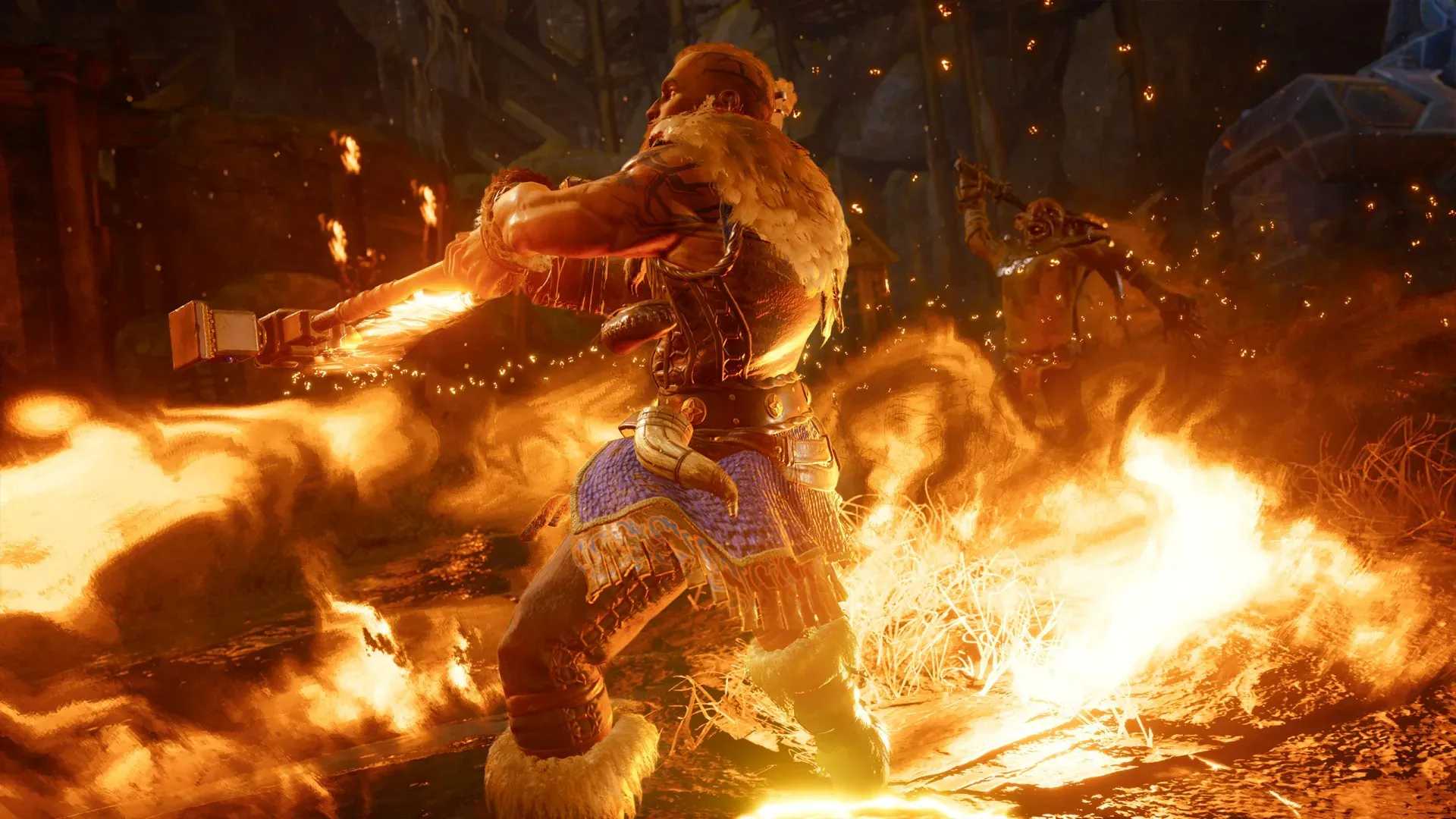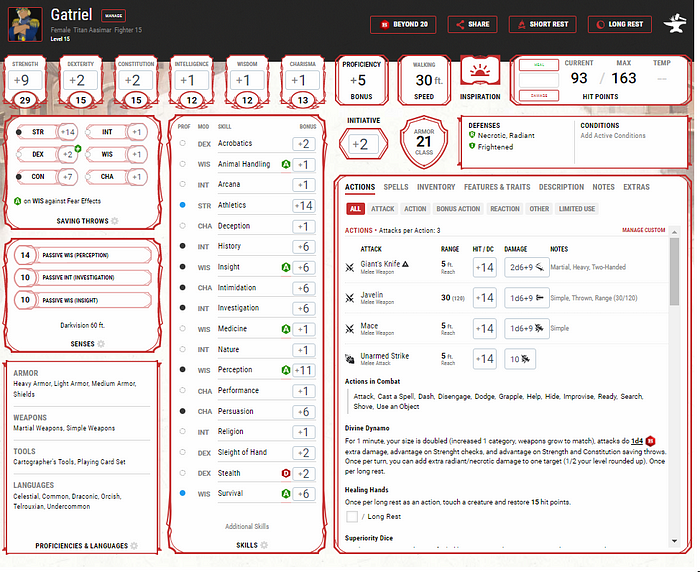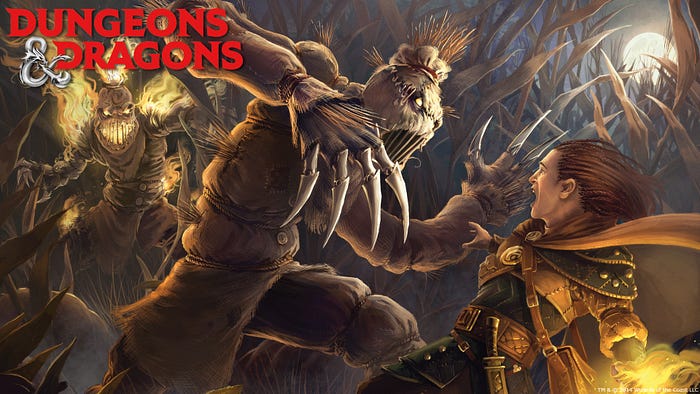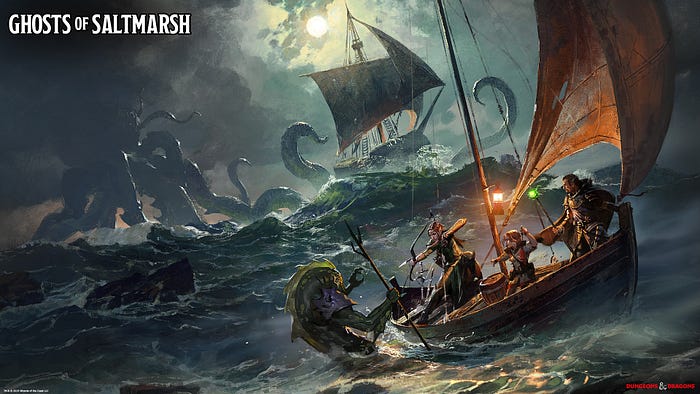Breaking Down the Dungeons & Dragons Character Sheet — Part 5
Fight for your life and learn how combat works in Dungeons and Dragons!

Welcome to session one! Your party is leaving their starting town, on their way to glory and fame, when suddenly they’re assaulted by a band of goblins who’ve been running a bandit gig on this well-traveled road to rack up some treasure.
You aren’t slouches, you’re adventurers! So, of course, you pull out your swords, bows, and fists and square up. It’s time for one of the best (in my opinion) parts of Dungeons and Dragons.
Yep, in this part of my ongoing character sheet breakdown, we’re talking about all things combat, from getting into the ring to getting out alive. Here’s what you need to know.

The Basics of Turn-Based Combat
The first thing you need to know about D&D combat is that it’s turn-based. That means that while in-game, the action might be happening all at once and chaotically; out-of-game, you’re going to have to wait your turn to do anything (most of the time).
Turns are divided into parts: movements, actions, bonus actions, reactions, and free actions. You can usually find all of your options for combat parts on the first page of your character sheet, either directly in the middle or in a box to one side. If you use DnDBeyond, your main combat actions are going to be in the large tabbed box on the lower right-hand side of the sheet.
Movements
The movement in a turn is, as the name implies, how far your character can move from where they started their turn. This is determined by your walking speed, which is how far you can walk in 6 seconds. It’s assumed that you take your subsequent actions during or immediately after your movement, therefore not taking up any more time. The typical walking speed in D&D is 30 feet per round.
There are some status conditions that can change your speed. For instance, being Grappled (more on that below) takes up movement to get free, while rough terrain may take more time to cross, cutting your movement in half.
Actions
Actions are the main part of your turn. The things you can do with an action take the longest to perform during your turn, at 6 seconds. Yes, you did read that right. No, it isn’t very long. No, I don’t know why it’s only 6 seconds.
The official list of actions, according to Wizards of the Coast, is:
- Attack — does exactly what it says on the tin. You attack with a weapon to do damage. Some classes gain a feature as they level called Extra Attack, letting them make…well, extra attacks, as part of their action.
- Cast a Spell — again, pretty straightforward. You cast a spell to have some effect on yourself, your team, your enemies, or your environment.
- Dash — you move up to twice your walking speed total in that turn (so, if you took a movement, you can move up to your walking speed again).
- Disengage — you stop fighting the enemy and leave the fight (this takes you out of the initiative order).
- Dodge — you get out of the way of incoming attacks.
- Grapple — you grab an opponent and wrestle with them, restricting their movement and preventing attacks. Escaping a grapple requires a contest of Strength checks — if your opponent gets a higher roll, they get out of your grip.
- Help — you help a teammate perform a maneuver of some kind. This gives them an advantage on their roll to accomplish it.
- Hide — you hide! You roll a Stealth check to stop the enemy from seeing you so you can either get away, avoid getting hit, or, if you’re a Rogue, go in for the surprise kill!
- Improvise — this is the “anything not covered here" option. Basically, you take the Improvise action whenever your DM lets you do something unconventional in battle.
- Ready — you prepare to take an action. You give the DM a specific condition under which your character will take an action (ie, “I’ll help Halburd the Strong lift up the barrel of wine when he reaches it next turn”) and hold this part of your turn until that condition is met.
- Search — you search the area for something.
- Shove — you shove an enemy five to ten feet away from you.
- Use an Object — exactly what it says on the tin! You use an object in your inventory or in the room. This might mean pulling a lever, opening a heavy door, or throwing something.
Bonus Actions
Bonus actions are things that don’t take a full 6 seconds to do. Unlike actions, there’s no singular bonus action list. Instead, each class and race — as well as some feats and backgrounds — will grant you certain bonus actions you can take.
For instance, my Fighter, Gatriel, has a bonus action called Two-Weapon Fighting as a class feature. On her turn, after she makes an attack with a one-handed weapon as her action, she can make an attack with another one-handed weapon in her off-hand as a bonus action. Considering she’s a level 15 Fighter with Extra Attacks, that means she can hit things up to three times in a single turn! And that’s before any other features are considered. She’s a hell of a tank.
Rogues mainly use their bonus actions to hide before the start of their next turn (a lovely little class feature that lets them use their Sneak Attack), while Barbarians mostly use it to Rage (see more about that in my basic classes breakdown).
Bonus actions can be attacks, spells, or movement types that enhance your action or give you or the party some other kind of advantage.
Reactions
Reactions are short actions you can take at any time during the battle, even when it’s not your turn. You can only take one Reaction per round, so you have to be careful when you use it and how.
Reactions can be used to lessen or even avoid taking damage, protect other players, stop a fleeing or moving enemy, or do all manner of fun things. Like bonus actions, they’re based on your class, race, and feats, and will differ from character to character.
Free Actions
Free actions are actions that you can take whenever you like that don’t really affect the flow of battle. The most frequently used free action is talking, as your character can say anything they like whenever they like.
Some DMs also allow switching weapons as a free action, though you’ll want to ask them about this ahead of time; some consider it a bonus action!
Start the Fight — Initiative!
Okay, so you know the parts. Now it’s time to fight! Kind of.
As I said, D&D has a turn-based combat system. To determine the order of those turns, everyone involved in the fight rolls for Initiative. The initiative order is then used to keep track of who’s moving and when, as well as how long the battle takes to complete.
How Initiative is Determined
Initiative is determined by this formula:
d20 roll + Dexterity modifier + Class/Race/Feat bonuses
That second part, the Dex plus bonuses? That’s called your initiative bonus, and it’s listed in its own box at the top of the first page of your character sheet.
If your character or characters are surprised by the enemy, or if the enemy is surprised by you, then you enter something called a Surprise Round before the actual initiative order takes place. Though many DMs do Surprise Rounds differently, a common standard is that whoever has the highest passive initiative roll (10 + initiative bonus) goes first.
After that, the initiative order is followed in order of highest roll to lowest and repeats at the end of each round. Characters who roll the same number go on the same turn, though the person with the higher Dex mod normally describes their turn first, for the sake of consistency.
Ending Initiative
Initiative ends when all combatants disengage. This can happen by:
- Killing all the enemies (Yay!).
- Your entire party dying (Yikes!).
- Everyone on one side running away.
- Talking one side out of attacking and starting a diplomatic meeting.
Believe it or not, all of those situations and their random combinations are equally possible, depending on your party’s attitudes toward the enemy and your luck. The most common way to end initiative, however, is to just slaughter your opponents.
When initiative ends, you’re officially out of combat and free to move around and do what you want, when you want.

Battlefield Complications
As in real life, in D&D combat, there are going to be some complications. These complications come in the form of mechanics that impact the intensity of damage, the terrain you’re fighting in, and the big ol’ monster you’re fighting, and they can mean the difference between an easy win and a long multi-round slog.
Conditions, Immunities, and Resistances
Status conditions are things that can affect your character as a result of their or another character’s actions. They’re things that make taking your turn a little more complicated. The conditions you can suffer from in D&D are:
- Blinded — your character can’t see. They fail ability checks requiring sight and have disadvantage on attack rolls. On top of that, anything attacking them has advantage!
- Charmed — your character is enamored with and under the spell of another creature or character. They can’t attack the person charming them or target them with magic that might hurt them. The charmer also has advantage when interacting with your character (though, not to attack them).
- Deafened — your character can’t hear. They fail any ability checks requiring hearing.
- Frightened — your character is afraid of something, either because of magic, intimidation factor, or a phobia. They have disadvantage on pretty much everything while they can see the thing that’s scaring them, and they can’t get any closer to it.
- Grappled — your character has been physically grabbed by another creature or character and is wrestling with them. They can’t move other than to roll to get away from their attacker. Grapples end when one of the characters involved is incapacitated or hucked off.
- Incapacitated — your character is out of it for some reason. They can’t take actions or reactions of any kind.
- Invisible — you turn invisible to the naked eye. Unless they’ve got magic, no one can see you and you’re considered heavily obscured, meaning things have disadvantage on trying to hit you but you have advantage on trying to hit them.
- Paralyzed — your character is frozen in place. They can’t move or speak and they fail any Strength or Dex saves. Attacks are automatically critical hits if they’re made within 5 feet of your character. You’re considered incapacitated.
- Petrified — you’re transformed into stone or another inanimate material. Your character’s weight increases 10 times over, they stop aging, and they become totally unaware of their surroundings. All attack rolls have advantage, but they’re also resistant to pretty much everything as well as being immune to poison and disease (because, y’know, stone). They auto-fail Strength and Dex saves.
- Poisoned — your character has been poisoned, either physically or magically. They have disadvantage on ability checks of all kinds and attack rolls. They’ll also slowly lose health until the poison is cured.
- Prone — your character is knocked to the ground. They have to spend their whole movement just to stand up and have disadvantage on attack rolls while they’re on the ground. Creatures that are within 5 feet of your character get advantage while attacking; any further away and they’ve got disadvantage.
- Restrained — your character is being held back by something, either physically or magically. They can’t move and they have disadvantage on attack rolls and Dex saves. Attacks made against them have advantage.
- Stunned — your character has been knocked around or shocked out. They’re incapacitated, can’t move, and can barely speak. They fail Strength and Dex saves and have attack rolls made against them made at advantage.
- Unconscious — your character is out cold. They’re prone and incapacitated, and drop whatever they had in their hands. Attacks have advantage against them, and attacks made within 5 feet of them are automatic crits.
Exhaustion
Exhaustion is a mechanic that some DMs use (though some consider it overkill) to measure how tired your character grows from doing the strenuous things that come with being a hero.
Exhaustion might be caused by extreme temperatures in the terrain, difficult terrain to move through, or particular abilities your character has. For instance, in a campaign I’m playing currently, we had a cursed Barbarian who went into an uncontrollable Rage. He couldn’t stop it, so ended up taking on levels of exhaustion each time he tried and failed. He got more and more frenzied until finally, he hit six levels of exhaustion, and, well…you’ll see.
This condition gets its own category because of how it works. There are six levels of exhaustion, each building on the previous level:
- You’re tired. You’ve got disadvantage on ability checks of all kinds.
- You’re really tired. Your walking speed is halved.
- You’re hitting a wall. You’ve got disadvantage on attack rolls and saves.
- You’re barely moving. Your hit point maximum is cut in half.
- You’re dying. You can’t move.
- You die.
When you hit six levels of exhaustion, you die. There are no saves involved. You just…die. Your heart literally gives out. It’s not a pretty situation to be in.
Luckily, exhaustion is pretty easy to cure in most cases. Long rests take away one level of exhaustion at a time, and some spells (like Greater Restoration) can remove levels of exhaustion as well. Still, you have to be careful out there! You may not have a chance to rest, and sometimes, you just run out of magic. Keep track of your exhaustion levels — it might just save your life.

Terrain
The terrain — or, the area in which your party is fighting — has a big effect on the battle itself in some circumstances. While it’s normal to have a fight in a clearing in a forest or a large dungeon chamber, it’s much harder to fight when your space is restricted.
When you’re fighting in an unusual place — a bog or swamp, a dense forest, a windy desert, etc. — your DM may determine that you are encountering difficult terrain. This means that you can only move at half speed through it no matter what you’re doing.
There are also some spells that cause difficult terrain conditions. My favorite is Wall of Thorns. This creates a massive, five-foot-thick wall of prickly, thorny vines. Passing through it counts as extremely difficult terrain (taking up to four times your movement speed to get through it), and can inflict damage when you enter it and if you end your turn there. It’s a common spell for Druids to take; there’s no wondering why.
Of course, there are also ways to bypass difficult terrain. Rangers, for example, can pick up features from certain subclasses to completely negate the effects of terrain; if you’re studying the land long enough, you’re bound to know some ways around it.
Up Next — Inventory!
I have a few last-minute tips for combat before we move on:
- If you’re a Rogue, your strategy is Hit, Move, Hide. Rogues at level 2 and up get Cunning Action, which lets you Hide as a bonus action. That means that the enemy can’t spot you, so you have advantage on your first hit against them. Guess what? That means you can apply your sneak attack damage.
- Fighters, use Action Surge!! Do it!! You get to hit four times, which might just bring down the creature you’re up against.
- If you’re a spellcaster, try to have at least one attacking cantrip or one melee weapon you’re really good with. You don’t want to be up the creek without a paddle if you run out of spell slots mid-fight.
- Always cast Mage Armor first.
Up next, we’re going to go over inventory! I’ll explain how you get items, how you carry them, and what attunement means. Happy adventuring!
